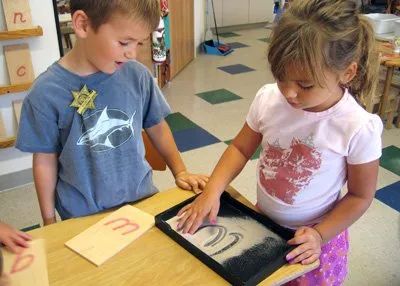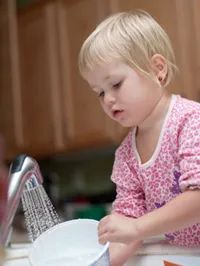On Raising an Independent Child
Raising a Selfish Lion, an Independent Child
What’s all this about selfish lions?
“Mom, Miss Lyndsey said we are supposed to be selfish lions,” said my three-year-old son after Montessori school one day.
Huh? I searched my memory for a clue, what was he talking about? Had he mentioned a book about selfish lions? Did the school have a grace and courtesy lesson about selfishness that involved lions? But that didn’t make any sense; surely, the lesson would have been not to be a selfish lion, right? I could only conclude that my son had misheard what his teacher had said. But my son insisted, “We must learn to be selfish lions, Miss Lyndsey says so!”
Call me crazy, but something just didn’t seem right.
“Miss Lyndsey,” I asked at the very next opportunity, “what’s all this about selfish lions?”
“Selfish what?”
“Lions…my son tells me that you encourage the children to be ‘selfish lions.’”
Miss Lyndsey looked puzzled, then got that “ooooooh” look. The next thing I knew, she was obviously trying not to laugh.
“Self-reliant!” she said, stifling a snort. “We encourage the children to be self-reliant.”
Oooooooooh. Well that did make a lot more sense. Montessori education considers self-reliance, independence, and confidence to be vital lessons for lifelong skills.
Self-Reliance Gained Through Personal Success
But how, you might wonder, can an educational approach teach important life skills like self-reliance? Montessori’s teaching method is based on a deep respect for the child as an individual. Children are able to choose, from a carefully prepared environment, the lessons that interest them most. This allows them to practice making independent choices, to work autonomously, and to feel the inner pride of accomplishment upon successfully mastering each lesson.
 As the child progresses through the prepared exercises, she will develop confidence in her own understanding and decision-making abilities. Most Montessori lessons are self-correcting, meaning that the child will be able to see for herself whether or not she got it right. If not, she will be given as much time as she wants to master the task. These techniques reduce the need for external correction, which can lead to feelings of failure and stress.
As the child progresses through the prepared exercises, she will develop confidence in her own understanding and decision-making abilities. Most Montessori lessons are self-correcting, meaning that the child will be able to see for herself whether or not she got it right. If not, she will be given as much time as she wants to master the task. These techniques reduce the need for external correction, which can lead to feelings of failure and stress.

Another important aspect of the Montessori classroom is the interaction among different aged children. Ideally, classes are comprised of children in a three-year age range. For example ages 3-6, 6-9, 9-12, etc. This encourages cooperative social interaction, which in turn builds social skills, friendships, and self-confidence. Also, children learn to respect others and themselves. While interacting with other children and adults in the classroom, and exploring with activities in their environment, children quickly learn about getting along with others and how things work.
“Such experience is not just play. It is work he must do in order to grow up.” ~Maria Montessori
Practical life Activities Also Lead to Self-Reliance
Another way that Montessori education teaches children self-reliance is through practical life activities. Dr. Maria Montessori discovered that children have an innate interest in “real-life” activities.

Often, as parents, we don’t realize that our children are not only interested in, but also quite capable of performing many common daily tasks. Here are some examples of practical life activities you might see in a Montessori school: children helping to set tables and prepare food. After snacks or lunch, they may help clear the table and clean the dishes. Children also help keep the classroom clean, sweeping floors with child-sized brooms or hanging up coats on hooks built within reach.
There are two important ways to ensure that children are successful at practical life activities: one is to provide children with the right materials, and the other is provide clear, step-by-step instruction. The appropriateness of the material usually boils down to size. Children must be able to manipulate objects in small hands, reach shelves, hooks, or tabletops, and lift/move smaller, lighter-weight items such as chairs or step stools. They must also be kept safe, nothing too sharp, hot, high, etc. Children can safely and successfully use real hammers and other tools, glass pitchers and cups, brushes, combs and toothbrushes, washtubs, drying racks, knives and cutting boards, to name a few, just as long as they are sized to fit into the hands and reach of the child.
Then, before the child attempts these practical life activities, she is given a detailed lesson. The child should watch an adult demonstrate the proper and safe technique. The demonstration should be broken down into steps which are pointed out and explained. Now the child is invited to try what she has just seen. The adult will then respectfully observe, only offering assistance when truly necessary. Remember, it is okay for the child to take a while, make mistakes, and even struggle a bit. Only help if the child is becoming frustrated, asks for assistance, or there is any kind of potential danger.
“Never help a child with a task at which he feels he can succeed.” ~Maria Montessori
The Montessori way of learning is not just for time spent in school. Through Maria Montessori’s wisdom and by using these tried and true methods, parents can teach their children the vital lessons of independence, resourcefulness, and selfish lions…I mean…self-reliance.
If you are interested in learning more about Montessori education, we welcome you to visit Age of Montessori’s information-rich website, watch our powerful webinars (free and professional development,) join our discussions on blogs and Facebook, and participate in our many online courses.






















